Six week’s ago, I walked along the north bank of the Thames from Tower Bridge to the Isle of Dogs, hunting some of the stairs down to the river. I am trying to trace all those that have been lost, and visit all those that remain. I have already covered a number of these fascinating places, and for this post I am at one of the probably lesser known stairs, Shadwell Dock Stairs.
The red circle in the following map extract shows the location of the stairs, between King Edward Memorial Park and the entrance to Shadwell Basin (Map © OpenStreetMap contributors).
Shadwell Dock Stairs are shown on the 1894 Ordnance Survey map, but in a rather unusual location as they are almost hard up against the entrance to the Shadwell New Basin. This was the eastern entrance to the London Docks, so must have been a busy place with ships entering and departing from the London Dock complex.
Credit: ‘Reproduced with the permission of the National Library of Scotland’
The reason they are there is explained by looking at an earlier map, the 1746 Rocque map of London which shows the stairs in place, long before the build of the Shadwell Basin. They are highlighted by the red oval in the following map.
The above map also explains the source of the name. If you look to the left of the stairs, there is a narrow channel leading a short distance inland to the street Lower Shadwell. This channel of water is named Shadwell Dock. There is a Timber Yard across the street, so perhaps Shadwell Dock was the route by which timber was landed to be moved to and from the Timber Yard.
So, I suspect it is safe to assume that Shadwell Dock Stairs are earlier than 1746, and were named after the nearby dock.
The Faithorne and Newcourt map of 1658 shows a continuous line of buildings along the river at this point, without the stairs or Shadwell Dock, so they must have been built in the years between 1658 and 1746.
UPDATE: Reader David Crowther highlighted in the comments a key point regarding the location of the stairs which I completely missed. In the 1746 map, Shadwell Dock Stairs are to the west of Labour In Vain Street, however in the 1894 map the stairs are just to the east of the same street. To check that this was not a mapping error in the 1746 map, I checked Horwood’s map of 1799 and that also shows the stairs to the west of Labour In Vain Street, the same position as the 1746 map.
The Shadwell Basin entrance was constructed in the 19th century, and aligning Horwood’s map with the position of the basin entrance shows that the original position of the stairs was where the new entrance would be constructed, so the stairs were re-built just to the east of the basin entrance, to the new position shown in the 1894 map.
This perhaps demonstrates the importance of the stairs, in that they were not simply lost when the Shadwell Basin was constructed, but were rebuilt just to the east of the new basin entrance.
The following maps (1746 on left and 1894 on right) clearly show the change in location between Labour in Vain Street (red oval) and Shadwell Dock Stairs (yellow circle).
My thanks to David for finding this.
Shadwell Dock Stairs today are fenced off and show evidence of an alternative use of providing access to the river. They are located on the pathway that leads from Glamis Road to the southern end of the King Edward Memorial Park, where the northern ventilation / old pedestrian access building for the Rotherhithe Tunnel is located.
This is the view looking towards the top of the stairs. The walkway is behind the fence at the top of the photo.
The LMA Collage archive has a similar view of the stairs from 1978, when much of the land behind was still derelict.
The clue as to the most recent use of the Shadwell Dock Stairs is found in the space between the stairs and the entrance to Shadwell Basin. This space is now occupied by Shadwell Basin Outdoor Activity Centre which provides water sport activities, and the Tower Hamlets Canoe Club.
The steps provided a launching route into the river for the adjacent organisations, however there now appears to be a much larger slipway built directly into the entrance to Shadwell Basin so I assume the stairs are now redundant, hence the current condition.
Boats would have been run down and up the metals runners which have been installed over the steps.
Shadwell Dock Stairs feature in numerous newspaper reports over the years. All the usual accidents, drowned bodies being found, crime, ships for sale etc. There are three reports that I want to cover, as they reveal some of the more unusual aspects of life on the river, centred around these river stairs.
From the Morning Chronicle on the 16th January 1841, a report which shows that it was not just the Thames around the area of the City that froze in winter:
“NARROW ESCAPE OF THREE WATERMEN ON THE RIVER – On Thursday night, at about six o’clock, three Greenwich watermen, who had been into the London Dock with a vessel they had brought up the river, were returning from the upper entrance at Wapping, when their progress was stopped by a large field of ice, which nearly broke their boat in two, and drove them towards Shadwell Dock-stairs. Here they were completely hemmed in among the ice, which extended from one side of the river to the other, and completely blocked up the navigation.
The boatmen endeavoured in vain to extricate themselves, and were at length driven nearly into the middle of the river. Here they remained stationary for some time, exposed to the sleet and snow.
Soon afterwards the ebb tide drove the ice a little further down the river, and again the poor watermen tried to get out, but with no better success than before, and the field of ice was again stopped by the barges and shipping.
The watermen continually hailed the people ashore to render them some assistance, but none could be afforded, and the masses of ice were not sufficiently consolidated together for any one to venture in safety.
The men at last began to complain of the wet and cold, and said they could not hold out much longer. They had been four hours among the ice and their situation became very critical.
Some watermen and lightermen ashore threw lines towards them, but they fell very far short of the boat. At ten o’clock, when they appeared quite exhausted, Judge, an Inspector of Thames police, and three river constables came to the spot at Shadwell and determined to make some effort to save them.
They borrowed two hurdles and some ropes. Constable Jones ventured as far upon the ice as was consistent with safety, and threw a line towards the boat, but the men were unable to catch it. The Thames Police, finding no time to be lost, and that the men were benumbed with cold, and incapable of any exertion, resolved upon a bolder attempt to save them.
A rope was fastened around Jones, the youngest and most expert of the party, and he placed one of the hurdles across the blocks of ice in advance of the one he was standing on.
After much difficulty, Jones got back with a second line he had made fast to the boat. On reaching the shore, the Thames police, with the assistance of five other men, pulled the boat right over the ice, with the three men in it, and brought it close alongside one of Mr Charrington’s coal barges.
The watermen were taken out and were conveyed to the nearest public house.
Their exposure to the snow storm had affected them so much that it was some time before they recovered; and had not the greatest attention been paid them one or more would have perished.”
Very descriptive, and looking across the river at this point, it is hard to imagine that it could have frozen, being much wider than in the City, but in reality the sheer number of moored ships and barges would have provided plenty of spaces where ice could aggregate, and tides would have broken free large sheets of ice which would have drifted around the river as described in the report.
There are a number or reports which mention a ferry running from Shadwell Dock Stairs, but so far I have not been able to find any detail of the type of ferry, the destination and for how long it operated. There was consideration of starting a large steam powered ferry service from Shadwell, similar to the Woolwich ferry, and in Lloyd’s List on the 15th February 1893, there is a report that the London County Council is proposing a ferry between Rotherhithe and Shadwell.
The article reports on the considerable differences in opinion of the effect on navigation of a two ferry-boat service running across the river at intervals of every 15 minutes throughout the day. The proximity to the entrance to the London Docks was identified as a risk, with a ferry being a serious danger to ships entering or leaving the docks.
The Rotherhithe to Shadwell ferry was part of a bill put before Parliamentary Committee, but the ferry proposals did not make any progress, the proposal for a road tunnel underneath the Thames was a much better option, able to move far greater volumes of traffic and with no impact on river traffic. The Rotherhithe Tunnel opened in 1908, and now runs underneath the river, very close to Shadwell Dock Stairs.
I have often wondered whether these Thames stairs were administered or overseen in any way, or whether they provided open access to the river. In the days when there was so much traffic on the river, with people and goods of all types being stored on ships and barges. Given the right tide, the river was probably the fastest method of moving across London. The Thames stairs were important gateways between the river and land.
An article in the London Sun on the 10th March 1868 mentions a Watchbox at Shadwell Dock Stairs.
The article reports on the trial of Thomas Deacon, a 19 year old lighterman who was charged with violently assaulting Edward Dove, a Waterman at Shadwell Dock Stairs. The report states that:
“The complainant said that the prisoner was a perfect nuisance at the place and was in the watchbox at Shadwell Dock-stairs last night with another man. They had no right there, and were requested to turn out, which they refused to do, and the prisoner, who is a strong and powerful fellow, struck the complainant a tremondous blow on the mouth with his clenched fist, and completely wounding the upper lip.”
Thomas Deacon was sentenced to two months of hard labour for the assault.
Watermen were higher in the river hierarchy than lightermen, and watermen had a range of rights covering their work on the river, and perhaps were involved in some form of policing, or watching over the river and stairs.
The Watchbox at Shadwell Dock Stairs possibly being part of this approach – a problem with writing this blog, researching any topic always opens up lots of additional subjects to investigate.
Looking down Shadwell Dock Stairs and the following photo provides a better view of the stones forming the causeway leading out into the river.
The LMA Collage archive has a better photo of this part of the stairs at low tide in 1971. Interesting in comparing the above and below photos, the 1971 photo did not have what looks to be some form of concrete / stone platform either side of the causeway. This must have helped with preserving the state of the causeway. The concrete appears to have replaced the wooden posts that once held the side of the causeway in place.
Looking west along the river with Shadwell Dock Stairs in the lower left corner. To the right, between the marker post and the opposite river wall is the entrance to the Shadwell Basin, showing how close the entrance is to the stairs.
Shadwell Dock Stairs are Grade II listed, and they were included in the impact assessments for the construction of the Thames Tideway Tunnel and close by is one of the construction sites for the tunnel, where part of the river facing walkway has been closed off. The following view is from the location of the Shadwell Dock Stairs, looking east, with the old Rotherhithe Tunnel pedestrian entrance, now ventilation point on the left, and the construction site on the right.
A small part of King Edward Memorial Park is now part of the construction site, but the major part of this park is unaffected. It is a park with a fascinating story, including competition for Billingsgate Fish Market. I wrote about the history of the park here.
Large, black, storage tanks form an interesting view along the southern edge of the park:
A longer view of the Tideway Tunnel construction site. Shadwell Dock Stairs can just been on the left edge of the photo.
Shadwell Dock Stairs were in existence before the London Docks, and the construction of the entrance to Shadwell Basin must have demolished the Shadwell Dock seen in the 1746 map, that the stairs must have been named after.
Shadwell Basin is the only remaining expanse of water from the London Docks, with the entrance to the basin being adjacent to the stairs.
A large lifting bridge remains over the entrance to the basin, carrying Glamis Road from Wapping Wall up to The Highway.
The section of the basin entrance between bridge and river is now occupied by the Outdoor Activity Centre.
Looking from the bridge in the opposite direction with the basin entrance leading into the larger Shadwell Basin. The towers of the City in the distance.
At the risk of sounding repetitive as I have mentioned this in my previous posts on Thames Stairs, I do find them fascinating. Shadwell Dock Stairs today is fenced off, but as with all the stairs I have looked at, they are a focal point for discovering the human history of the river and shore.
Standing by the stairs, we can imagine the thousands of people who have used the stairs to get to and from the river. The coming of the Shadwell Basin must have had a huge impact on the stairs. The times when ice from the frozen river broke up against the stairs, and the watchbox that must have been a scary place to sit on a dark winter’s night – all part of London’s centuries old relationship with the River Thames.

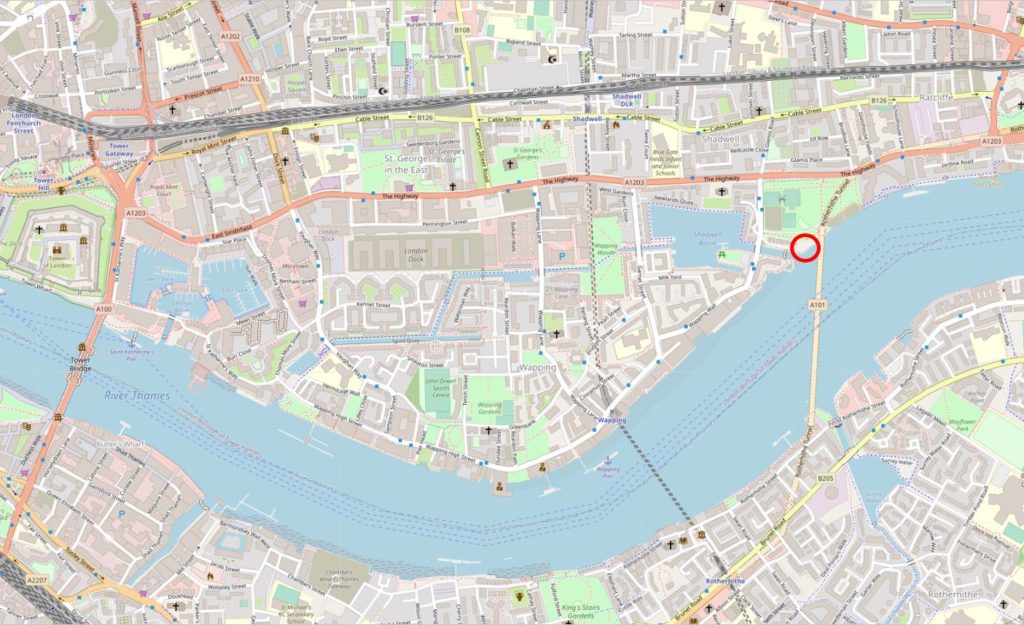


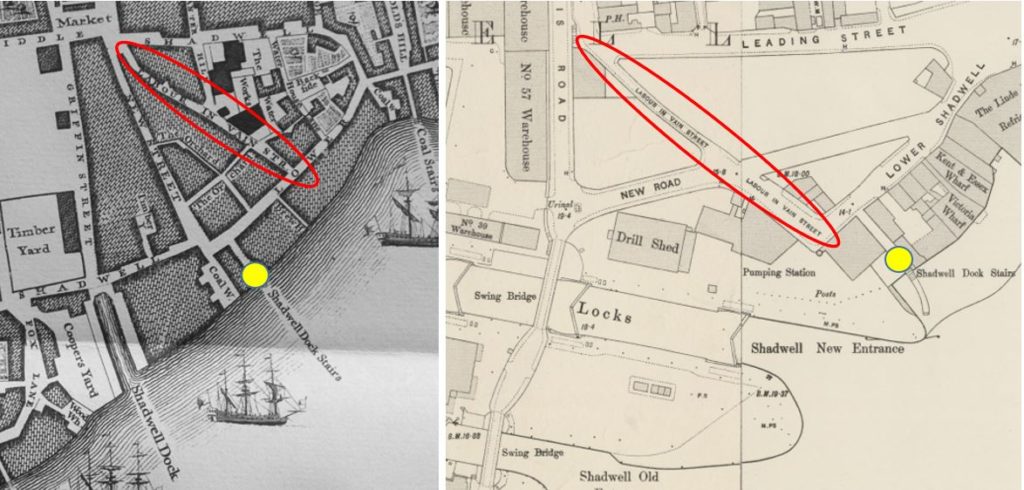
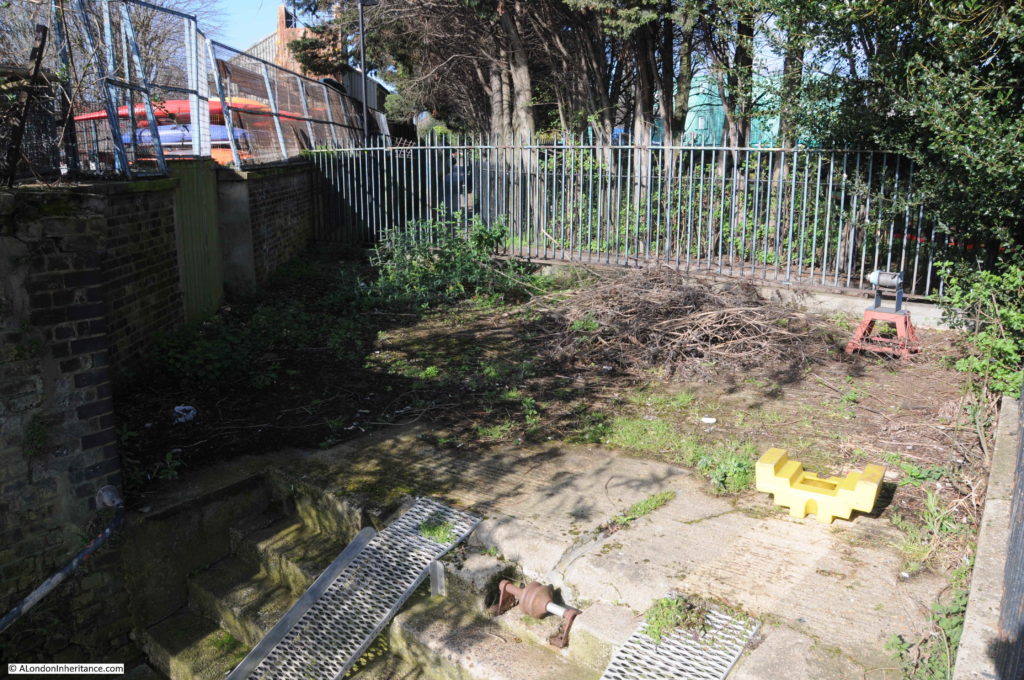
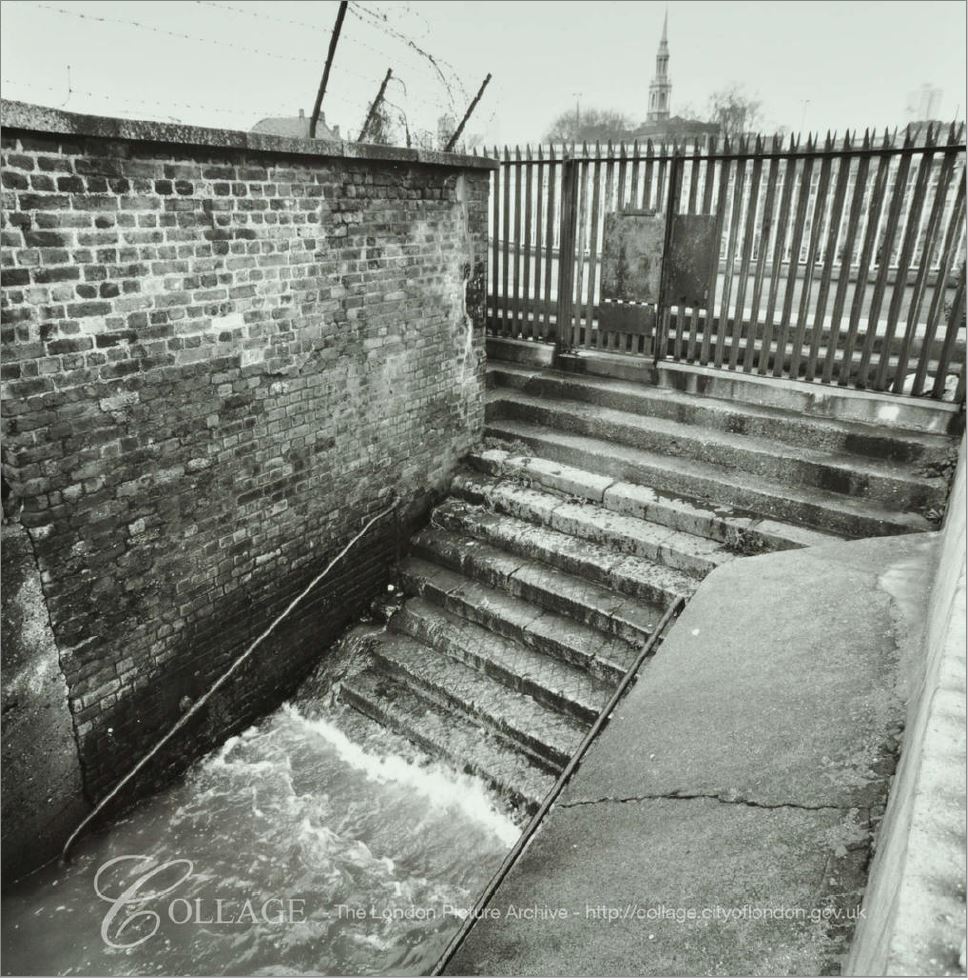
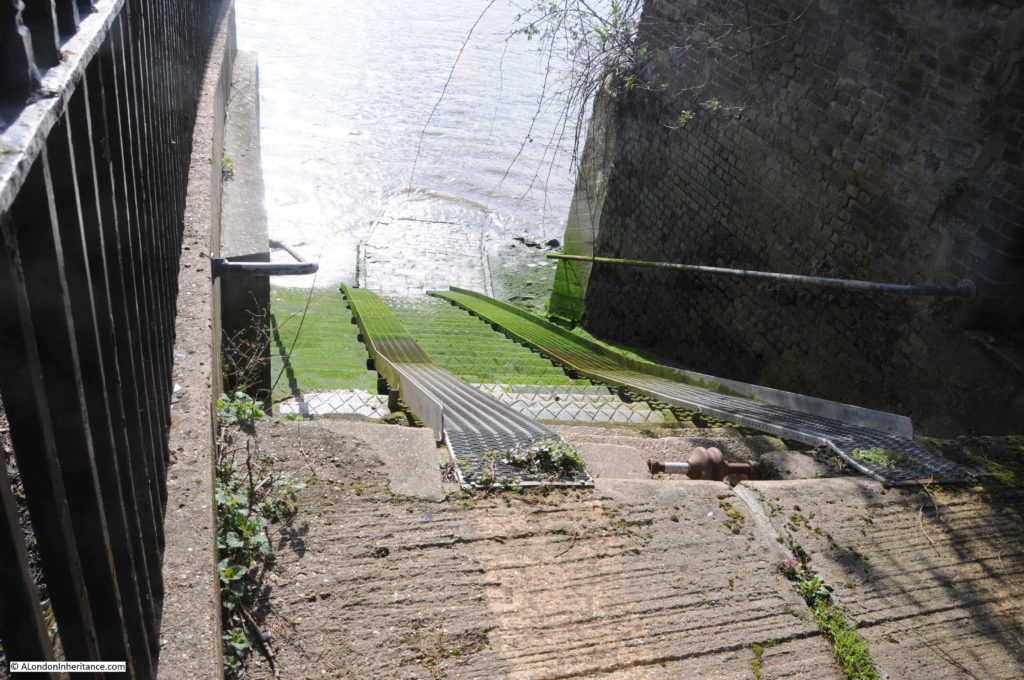
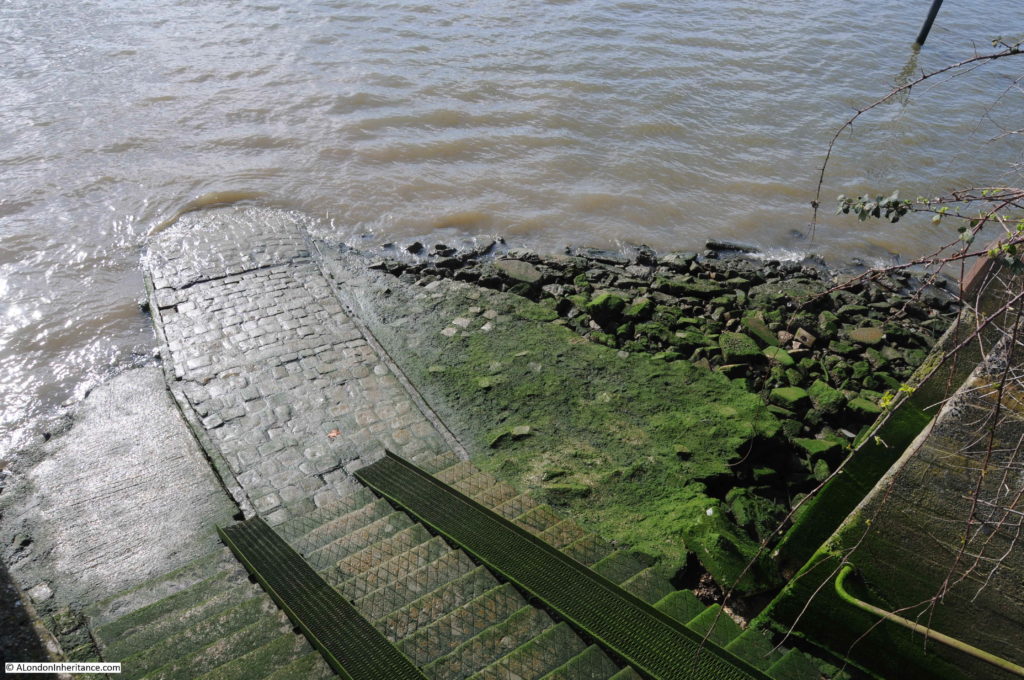
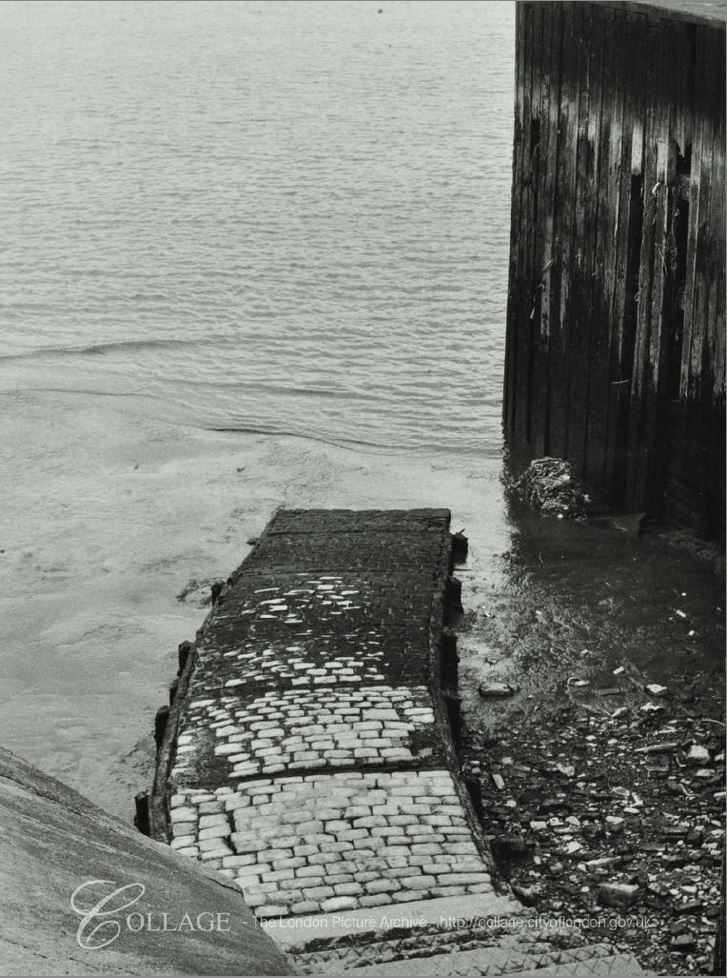
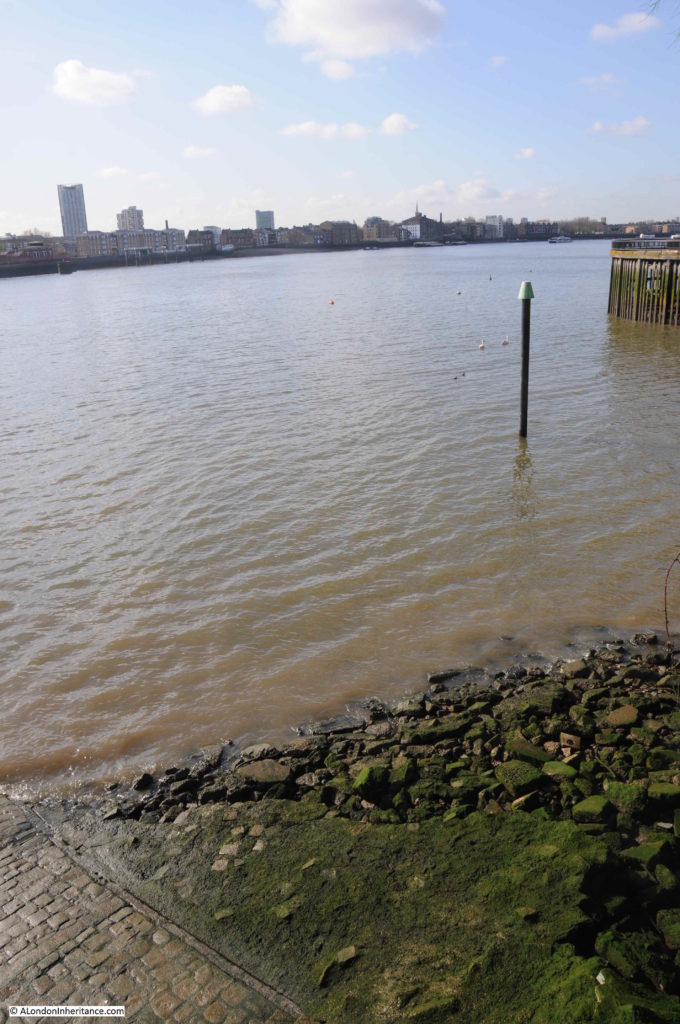
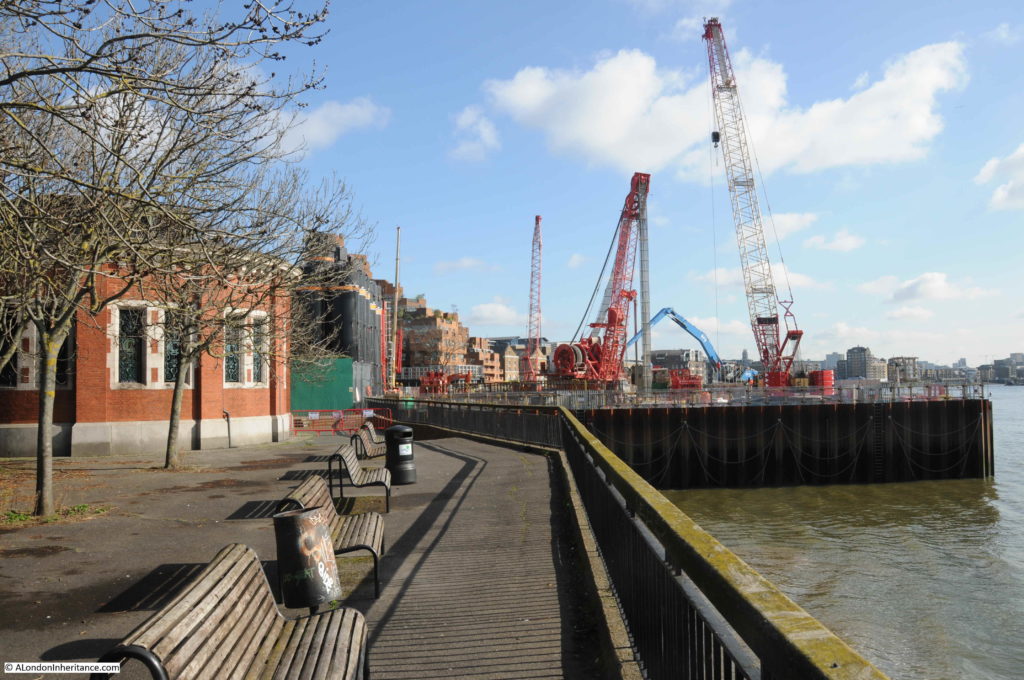
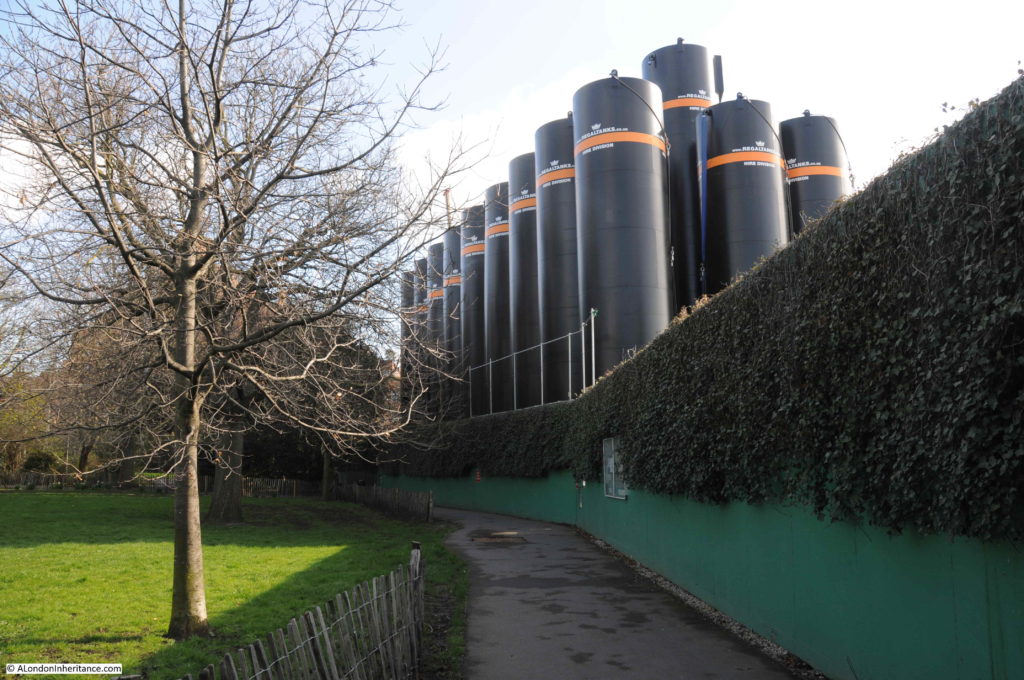
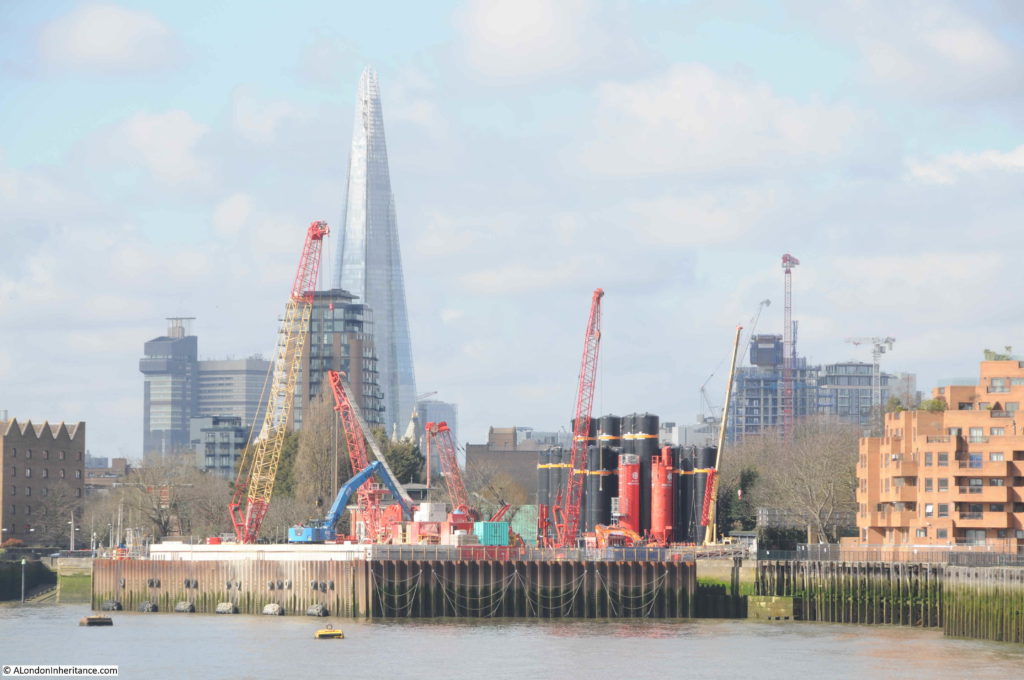
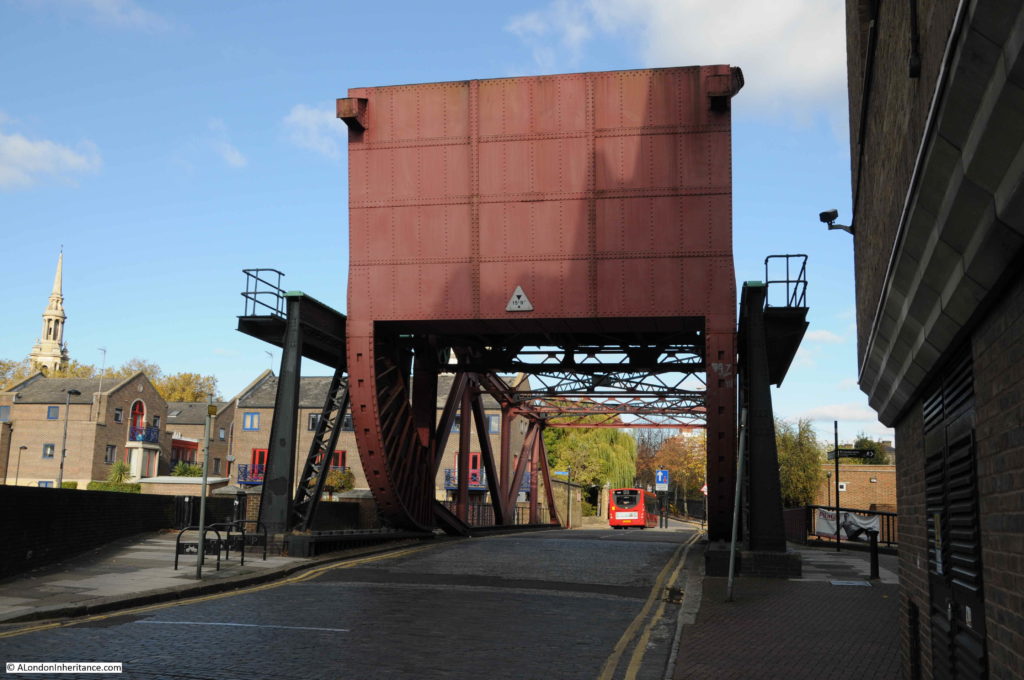

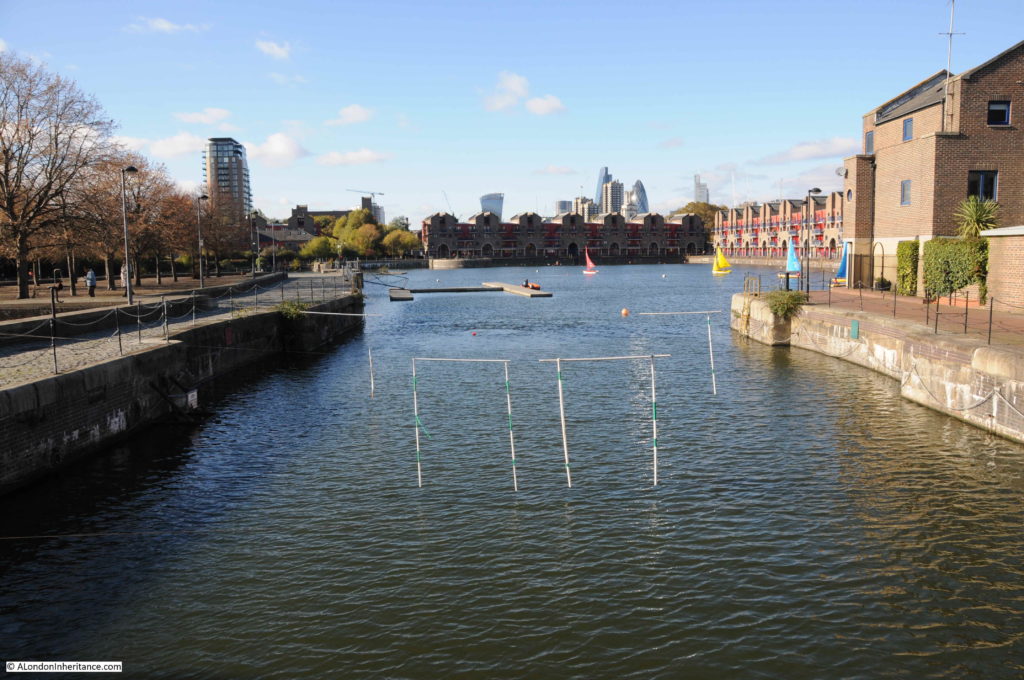
Please subscribe me to your blog!
Hi Kathryn, you should see a subscribe field on the right of the blog, you can enter your e-mail address which will generate an e-mail to you for confirmation. Many thanks for your interest in the blog.
I am puzzled by the location of Shadwell Dock Stairs in relation to Labour-in-vain street (a lovely name!) on the two older maps. The 1746 map shows the stairs well to the west of the street, while the 1894 one shows the stairs to the east of the street. Do you think that the stairs were rebuilt to the east when the dock cut was made, or could it be a mapping error?
PS many thanks for these excellent, interesting and informative articles
David – thanks for pointing this out, I was concentrating on the history of the stairs and missed their change in position in relation to the streets.
I checked Horwood’s map of 1799 and they also show the stairs to the west of Labour-in-vain street, so it was not a mapping error on the 1746 map. The original stairs were located where the entrance to Shadwell Basin would be built in the 19th century, so they must have been moved from their original location when the entrance to the basin was built, to the location on the 1894 map.
Thanks again, I will update the post with a credit to you for the discovery.
There is also a literary link to Shadwell Stair and the WW1 poet, Wilfred Owen, who wrote an atmospheric but also rather ambiguous poem titled: “Shadwell Stair” in 1918:
I am the ghost of Shadwell Stair.
Along the wharves by the water-house,
And through the cavernous slaughter-house,
I am the shadow that walks there.
Yet I have flesh both firm and cool,
And eyes tumultuous as the gems
Of moons and lamps in the full Thames
When dusk sails wavering down the pool.
Shuddering the purple street-arc burns
Where I watch always; from the banks
Dolorously the shipping clanks
And after me a strange tide turns.
I walk till the stars of London wane
And dawn creeps up the Shadwell Stair.
But when the crowing sirens blare
I with another ghost am lain.
Thanks for that, Tim. I was looking for the location of the poem, and that’s what brought me to this site.
The Shadwell Stair(s) was/were a place for what’s now known as homosexual “cruising” and brief sexual encounters around the time the poem was written. That makes a lot of the poem clear – the poet is hanging around the stairs, lonely and despairing, all through the night. He moves secretly and quietly like a ghost, and like a ghost has to depart as soon as dawn comes.
The poem is not only for gays, but for everyone who feels loneliness at night and is sensitive to the atmosphere of an urban location like Shadwell, a place with such long memories and so busy during the day and so abandoned at night. Very like Wordsworth’s mood on Westminster Bridge .
I have sat next to these stairs so many times, it is so interesting to know the history of them,many years ago I remember going down the stairs of the Rotherhide tunnel strange when you think that we use to walk through the tunnel, something that you wouldn’t dream of today, Thanks so much for the memories .
Yes I and my brother’s used to walk through the tunnel and go up some grand circle of stairs half way through and be i n Shadwell Park ! Late 60s
Absolutely fascinating as with all your posts, congratulations on all your very interesting posts, I always look forward to receiving the next installment.
Hard to believe that I walked over that lift bridge twice a day in my youth on my way to Raines Grammar school. Great photo thanks !
Playing in Shadwell Park when very small, a good friend was one who had slim hands and wrists so that they could slip a hand through the railing gate to undo the ‘Yale’ lock holding the gate closed. Once the adventure had finished, simply close the gate and nobody would know unless spotted by a Police launch on the river. Ah happy dangerous days
As always, enveloping us in our London history and brings us closer to all our ancestors who walked these streets before us. Thank you, what you write for us is very appreciated.
Thank you again for a post where my ancestors may have walked and worked being Watermen and Lightermen in Victorian and Edwardian days. My grandfather being born and brought up from 1891 in Brooke street (now the top end of Cable street ) sadly would not talk about anything relating to his early years or ancestors. He just used to say ” I left that behind long ago.”
In searching the census records I know the Wilson family were 2/3 generations living and working in the Wapping area in those days.
My grandfather was able to become a clerk after leaving school and after serving in WW1 (something else he would never talk about) maried and moved to a new house he bought in Romford.
Well done sir love the history of this area
Many thanks for another fascinating post. I too am interested in the history of the river stairs and have wondered if there was any supervision of them. As you note maybe the watermen were involved in that.
Good evening,
Fascinating history. My son recently moved to this area(just by Shadwell DLR). A lovely cosmopolitan atmosphere with vibrant markets. Recently discovered the outdoor pursuits centre, a lovely addition reflecting the ever changing face of the river. And when you are in need of refreshment after a day’s history lesson the ‘Prospect of Whitby’ is a great Pub to finish your walk!
Thank you ‘A London Inheritance’ for helping to fill the long hours of the current Lock down!
What an unanticipated benefit from this necessary lockdown ~ dating from March 15 out here in Santa Monica, California ~ to have a midweek posting, David. Thank you so much.
A comprehensive, well-documented history of the Thames steps is surely missing from the publishing world. I wonder if the Museum of London would consider sponsoring such. I’d say you have the bona fides.
A lfe-long resident, these stairs are familiar to me. On my daily lockdown walk recently, I was glad to be able to point out the stairs, and mention the poem, to a couple who had stopped to take in the views. They were absolutely fascinated.
Small matter of notation. The reference to ‘towers of the City’ under one of the photos, should read ‘towers of newly constructed Canary Wharf’.
Very informative post, though, with the photos and maps. Merci
For S. Donovan
Check website SpitalfieldsLife.com for a good interview with Mr John Olney, current ‘guvna’ of Donovan Bros. The old shop 46 Crispin St still bears the signwriting.
Thanks to ALondonInheritance.com
smiles,
Another Donovan